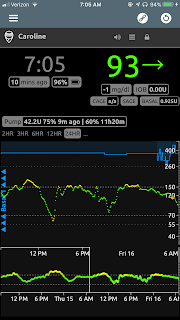Cat has been wearing the Medtronic 670g hybrid closed-loop pump with the Guardian 3 sensor and we have LOVED this pump. I've been using it since January 2019. It really keeps her (us) mostly steady unless we have an "oopsie" with carb counting, have a growth spurt, have extra activity, or have a bad pump site. (If you are not familiar, insulin is delivered subcutaneously through a small metal cannula that stays taped down to her skin for 2-3 days). The 670g pump increases or decreases the basal (background) insulin based on her CGM data. So if her blood sugar is trending high, the pump delivers more background insulin. If her blood sugar is trending low, the pump decreases or stops delivering the basal insulin for a while. Medtronic bases their micro-boluses (automatic basal delivery) based on the last 6 days of total daily insulin dosing.
The Tandem Control IQ promises to do this same action PLUS more. Not only does it adjust the basal rates based on the current blood sugar readings, it ALSO gives a correction bolus of insulin each hour if blood sugar is higher than target. So basically, if I mess up her carb counts, or forget to bolus, or if she's eating something that makes her BG go higher than normal for whatever reason, the pump will correct the high blood sugar IN ADDITION TO increasing her basal rates.
Control IQ uses the user-inputed correction factor (ISF) and then does 60% of this factor each hour if the BG is high. I have mostly left her high blood sugars alone because of this neato added feature on the pump. I think this will be a huge help at school. I did notice today that the Control IQ does not adjust basal rates when there is a certain amount of Insulin On Board (or Active Insulin).
Here's another weird thing I've noticed about Control IQ. If you have Active Insulin (Insulin on Board) from say, her dinner, sometimes it won't let me bolus her after dinner if she wants a dessert, even if I put in the carb count. I guess it's got some predictive features going on that I don't understand. Soooo....I guess the pump will correct her later if she starts going up from the Klondike bar? I always thought I needed to cover the carbs, no matter what.
Tandem also bases their basal insulin on the user settings. So if Cat's hourly basal rate is 1.0 units per hour, because that's what she would get on a traditional pump, that's what Control IQ uses. But it does adjust this up or down based on CGM data. Read the link I posted below for all of the deets about the ranges and targets for the Control IQ. I really like that the "Sleep" setting on the t:slim actually has a tighter range for nighttime.
The drawback to Control IQ is that IF your basal settings are not right, and IF your correction factor is not right, you will have some highs and lows. But of course, any pump is only as good as its user's settings. Also, the Control IQ sets the Active Insulin Time to 5 hours. You can't change this in Control IQ, nor can you change the target setting to anything below 110. On the 670g, Active Insulin Time was a huge factor in having success with Auto Mode. With ANY pump, it's important that you have your settings dialed in correctly.
It's a learning curve for sure, but I am really liking the no calibrations and no fingersticks AND the 10 day sensor. I'm looking forward to our 1 week phone conference with our trial coordinator to upload the data and discuss any changes...I'll keep you all posted!
Click here to read the ins and outs of the Control IQ system from Diatribe.
https://diatribe.org/tandem%E2%80%99s-control-iq-hybrid-closed-loop-algorithm-submitted-fda





















